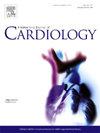抗凝治疗预防经导管主动脉瓣置换术后亚临床小叶血栓形成:综合文献综述及未来发展方向
IF 3.2
2区 医学
Q2 CARDIAC & CARDIOVASCULAR SYSTEMS
引用次数: 0
摘要
经导管主动脉瓣置换术(TAVR)后小叶血栓形成是一个重大挑战,导致不良的临床结果。亚临床小叶血栓形成(SLT)越来越被人们所认识,并且越来越关注其在临床事件和血流动力学瓣膜恶化中的作用。目前关于TAVR后预防性抗凝或抗血小板治疗的建议主要基于专家共识,而不是随机试验的明确证据,导致临床实践中的抗血栓策略多种多样。虽然观察性数据表明预防性抗凝可能是有益的,但临床试验结果并不一致,特别是对于没有OAC指征的患者。鉴于相互矛盾的发现和与预防性抗凝相关的潜在安全问题,进一步的研究是必要的。本文旨在对SLT的危险因素、预防策略、目前的建议和未来的研究方向进行综述,以更好地了解在这种情况下预防性抗凝治疗的益处和风险。本文章由计算机程序翻译,如有差异,请以英文原文为准。
Anticoagulation therapy for the prevention of subclinical leaflet thrombosis after transcatheter aortic valve replacement: A comprehensive literature review and future directions
Leaflet thrombosis after transcatheter aortic valve replacement (TAVR) presents a significant challenge, leading to adverse clinical outcomes. Subclinical leaflet thrombosis (SLT) is increasingly recognized, and there is a growing concern about its role in clinical events and hemodynamic valve deterioration. Current recommendations for prophylactic anticoagulation or antiplatelet therapy following TAVR are primarily based on expert consensus rather than definitive evidence from randomized trials, resulting in a variety of antithrombotic strategies in clinical practice. While observational data suggest that prophylactic anticoagulation may be beneficial, clinical trial results are inconsistent, particularly for patients without an existing indication for OAC. Given the conflicting findings and potential safety concerns associated with prophylactic anticoagulation, further research is imperative. This review aims to summarize the existing literature on risk factors for SLT, preventive strategies, current recommendations, and future research directions to better understand the benefits and risks of prophylactic anticoagulation in this context.
求助全文
通过发布文献求助,成功后即可免费获取论文全文。
去求助
来源期刊

International journal of cardiology
医学-心血管系统
CiteScore
6.80
自引率
5.70%
发文量
758
审稿时长
44 days
期刊介绍:
The International Journal of Cardiology is devoted to cardiology in the broadest sense. Both basic research and clinical papers can be submitted. The journal serves the interest of both practicing clinicians and researchers.
In addition to original papers, we are launching a range of new manuscript types, including Consensus and Position Papers, Systematic Reviews, Meta-analyses, and Short communications. Case reports are no longer acceptable. Controversial techniques, issues on health policy and social medicine are discussed and serve as useful tools for encouraging debate.
 求助内容:
求助内容: 应助结果提醒方式:
应助结果提醒方式:


